- Created by Jason Shawn, last modified by Lori Hart on Oct 19, 2023
You are viewing an old version of this page. View the current version.
Compare with Current View Page History
« Previous Version 106 Next »
Performance Tracker allows you to upload current STAAR and historical student score data files, generate Student Data Requests (SDR) files, and generate registration files.
To Batch Upload Score Files, click on the Performance Tracker tab in your District Management Menu and select Upload Data. A new window will open.
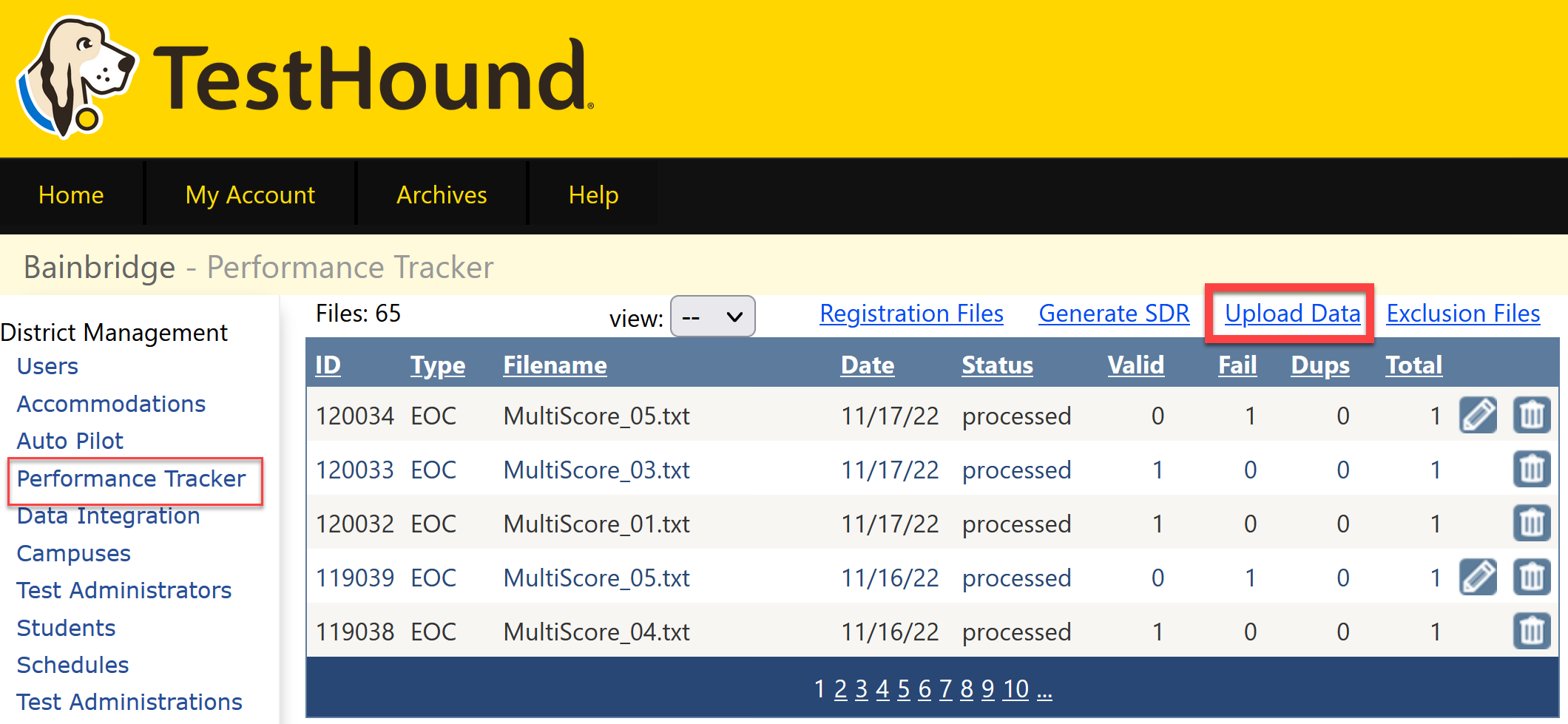
Next, using the name of the file, select a Data Set. For EOC files, find the 4 digit numerical code in the file name, which will tell you the admin and the year of the scores. EX: 1522 is Spring of 2022. 1320 is Fall of 2020.( For your reference, 13-Fall/Dec., 15-Spring, 16-Summer and the last 2 digits are the year.)

Then select the “Choose Files” button.
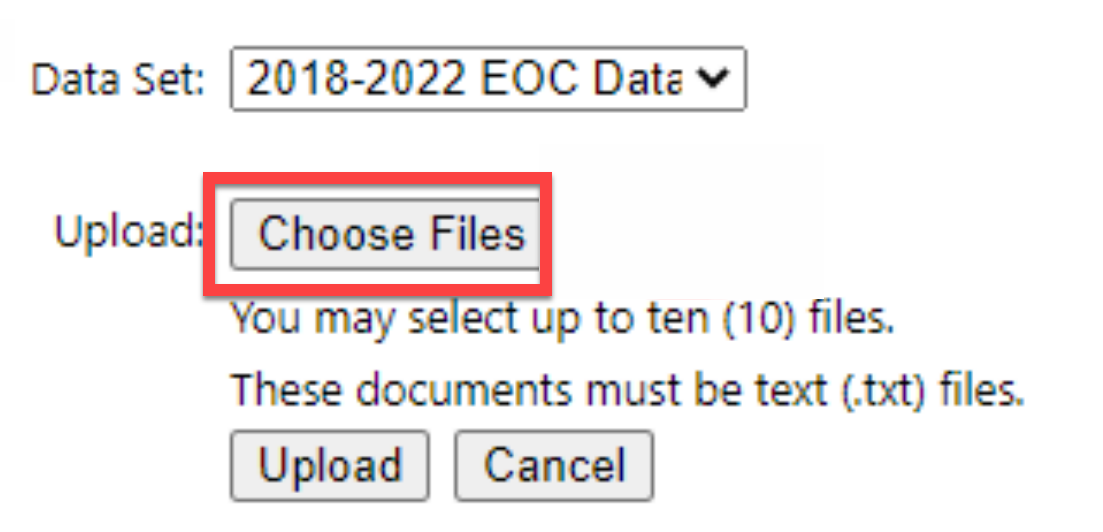
*Be sure to choose only .txt files. A maximum number of 10 files may be selected and processed per batch. To select multiple files for your batch, hold the ctrl button on your keyboard while selecting multiple files from your computer. All files chosen in the batch must match the same data set. Next, select the “Open” button. The selected file count will be displayed. NOTE: You can’t upload the zip file from the vendor. You must open it and download all the individual files inside, then upload those, in batches of 10, to Performance Tracker.

Then select the “Upload” button to upload your files.

After uploading, you will receive an email when the files have been processed. Each file will be displayed in your Performance Tracker table and show a status of ready. You do not have to wait for one batch to process before uploading the next batch.

Once the files are processed they will show a processed status in the table.

NOTE: When EOC data files are uploaded, Performance Tracker will pull in the cumulative test data records.
How Do I Know What Data Set to Choose for Performance Tracker?
SDR files and Score reporting files are named in a way that will identify the year the data is associated with. Files beginning with SF and Production Examinee are valid files to load.
The first part of the SDR file name begins with SF. The second string is the test administration + YY. The first 2 are the admin (13=fall, 15=spring, 16=summer) the last 2 are the year. Next, the file name will identify if it is an EOC or a 3-8 score file. For example, SF_1616_EOC_A1 is the Summer of 2016 EOC score for Algebra 1.

Important here is the last 2 digits in that 4-digit number, that’s the year. This indicates the data type selection that needs to be made when uploading the file into TestHound.
SDR files for grades 3-8 scores are listed as the month and year. SF_0519 would be in May of 2019. So again, the last 2 digits are what you look for.
After the file has been uploaded, a table will appear with the status of the file. Initially, the status will be "received" and when complete will change to "processed". The table will also indicate Valid records (records where test data was successfully matched) and Failed records (records where data was unable to be matched).
After the file has completed processing, a new table will appear with the names of students for whom test data has been associated.

Initially, 5 students will be shown. You may search for a student by typing in the local ID or to view additional students, choose 10, 25, or All from the View drop‐down menu.
By choosing Select next to a student’s name a table will appear to display the test data by subject or EOC course associated with the student.

If a student did not have a score code of "S" the cell with the student data will now reflect the score code that was assigned to the student and the box will be highlighted gray. For instance, a student with a score code of "A" will have SC-A displayed, or a score code of "O" will be displayed as SC-O.

A failed lookup is the result of a failed association between the State ID in the data file uploaded and the State ID in the demographic file submitted by the district. The most common reason this occurs is that the State ID may be inaccurate in one of the two files or the student is no longer enrolled in the district and the student's data is not being submitted via the demographic file.
To update failed lookups, select the Validate Failed Lookups icon (pencil).

A list of students with failed lookups will appear. If you know the student’s local ID you may type it in the text box and click GO to associate the test data to the student. Doing this will associate the data using the local ID instead of the State ID.

The file can be deleted along with the associated scores if it was uploaded improperly. To do so, select the Delete File and Scores button.

A new window will open stating that if the file is deleted it will also delete associated scores data. If you wish to proceed select Submit.

Performance Tracker will allow the creation of the SDR (Student Data Request) file that will capture test history for students who tested outside of your district.
Prior to generating the SDR file, download the 7-zip utility to open the encrypted file. (7-zip only works on PCs. Mac users will need to install a program such as KEKA or RAR Extractor)
Navigate to the following web address to download the free 7-zip utility program: www.7-zip.org
Once at the website, a table at the top of the web page will appear with the choices below:
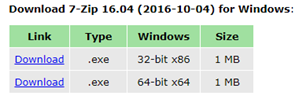
If unsure of the type that should be downloaded, select the link for the 64-bit version. Once the 7-zip utility is installed, return to TestHound.
**Before generating an SDR file, all student alerts should be accepted at the campus level to ensure all students are at the correct campus and all new students have been processed.** Cambium also requires that all students be “registered” in TIDE before they will release score data. You can use the “all student registration” file to upload to TIDE before you do an SDR. See the question “How Can I Generate a Registration file”. Upload the all student registration file and allow it to process before submitting an SDR to Cambium. When you are ready to generate an SDR:
In Performance Tracker, click Generate SDR

A new window will open giving you the option of pulling the SDR for only your flagged kids ( your new kids, kids who have re-enrolled, or kids without scores in TestHound) OR you can pull an SDR for ALL of your students in the event you feel that you have some kids whose scores did not populate when pulling the SDR at a previous time. It will prompt you to create a password that can be used to open the encrypted zip folder that will be sent to you. The password must be a minimum of 12 characters and consist of only numbers or letters. Once you have typed in the password select Generate.
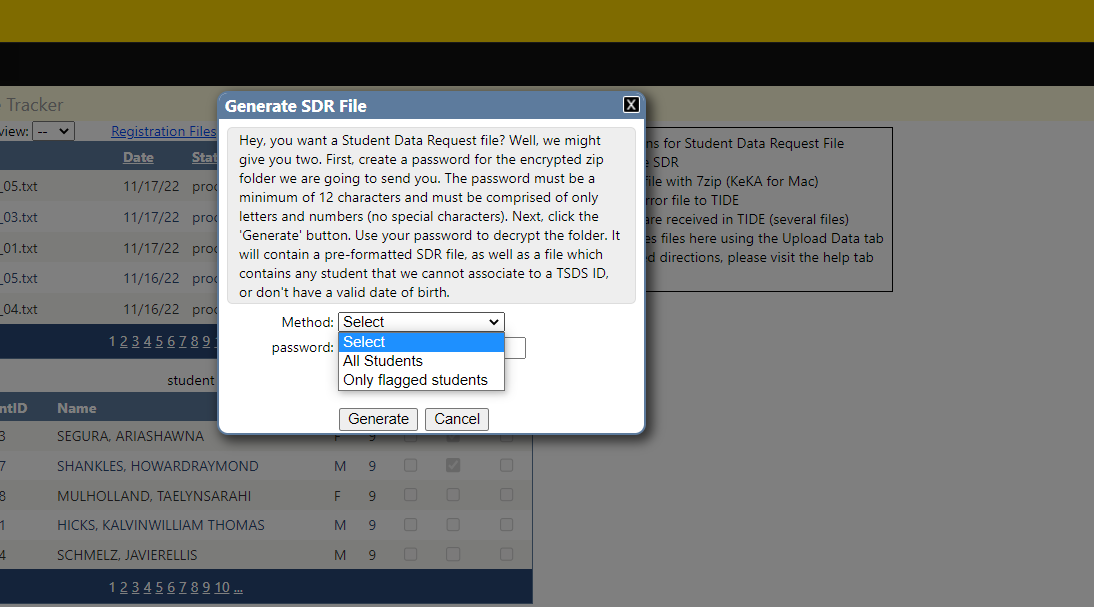
When the file has been downloaded right-click or in Chrome select the arrow to the right of the file name, then choose Show in folder.
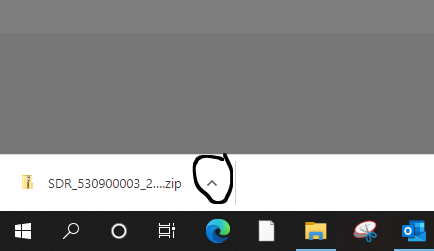
The Downloads folder will open and the zipped folder titled SDR_ [District ID] _[Date] will appear.

Right-click on the zipped SDR folder and choose 7-Zip > Show more options> Extract here.

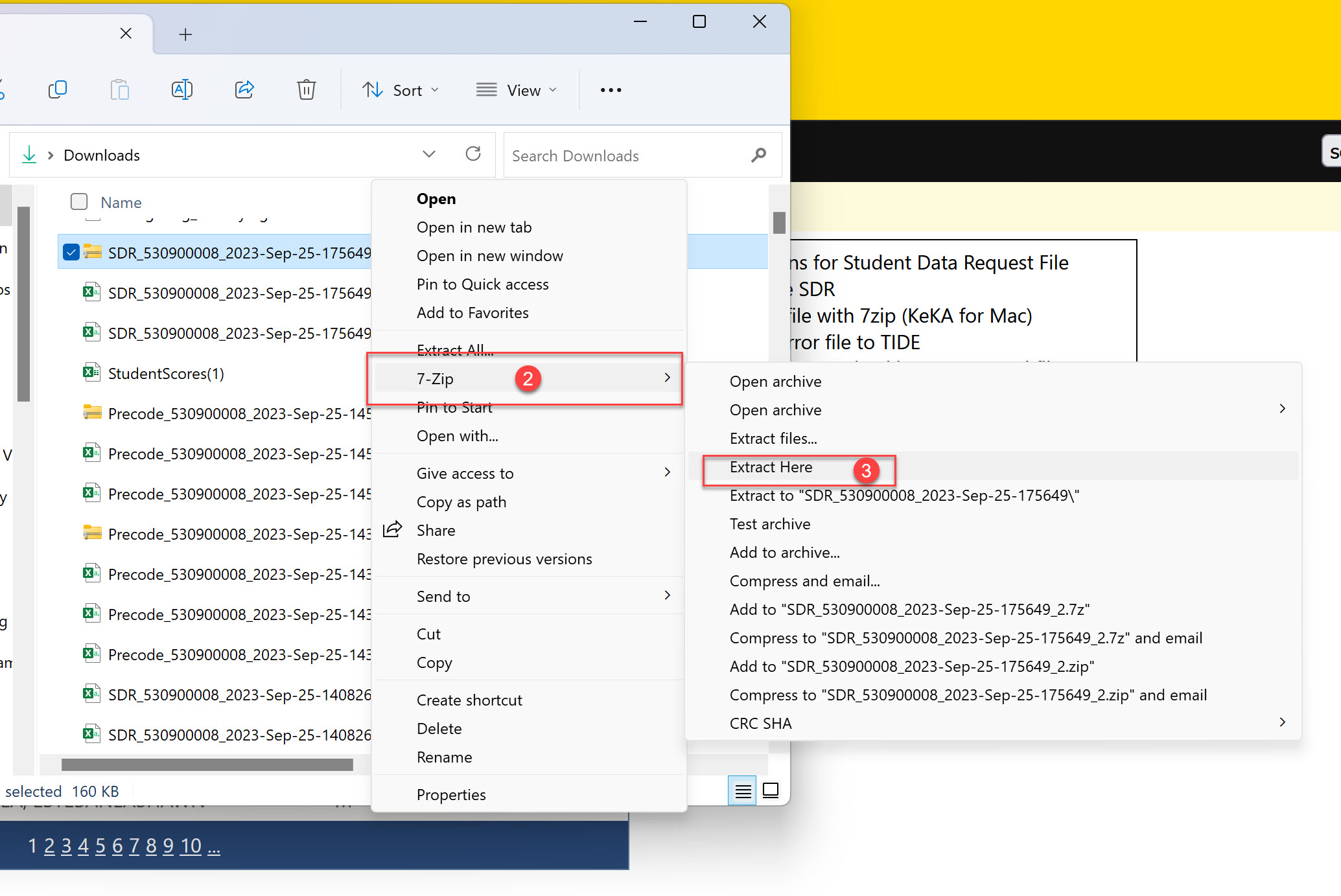
You will need to put the password in again.
The window below will open indicating when the files have been extracted. When the process is complete, select Close.
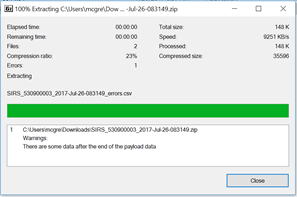
Under the zipped folder, there will be two files.

The first file will be the pre-formatted SDR file that can be submitted in TIDE to retrieve test data for students. The second file (with “errors” in the name, )contains records indicating students whose data could not be matched to a TSDS ID or Date of Birth in the demographics file being submitted by the district.
Once you have your non-error SDR file saved that you generated in TH.
Log in to TIDE. The TIDE dashboard appears.
From the Student Information task menu, select Student Data Request.
Select Browse
Navigate to and select the SDR file saved on your device.
Select Next. The Preview page appears.
Review the information on the Preview page and if the information is accurate, select Next.
Click the Continue with Upload button.
The Confirmation page appears, indicating your file has been uploaded.
After initial files have been loaded into TestHound you may pull an SDR to request performance history on new and re-enrolling students in your district. Before doing so, it is best practice, to have all campuses accept their student alerts so that you have the most up-to-date student information in your file. Students’ enrollment status in TestHound will indicate if they are pulled into the file. A score file should be uploaded after results from each test administration are received to keep performance history current.
Performance Tracker will allow the generation of a registration file that is uploaded to the state testing vendor to register students in TIDE. The “All Student Registration“ file will allow you to upload all your TestHound students into TIDE for ease in pulling a Student Data Request in Cambium to obtain past student test performance. The “All Student Registration” file will not register students for testing. It simply adds your students to the Cambium system.
You can also generate an “All Students with Test Registrations” file. This will automatically flag students for test registration. Students do NOT need to be in a test in TestHound. (Campuses should process all student alerts (new, unenrolled, reenrolled) prior to this, to ensure student statuses are updated. )
This new process will pull all students in grades 3-8 in TestHound into the file based on enrolled grades. TELPAS students will be registered for TELPAS testing based on their current EL status, and STAAR Alt students will be included based on that designation on their Accommodation page in TestHound. Retesters will be included using their performance history in Performance Tracker. Students who need to retest but do not have a performance history in TestHound can be added to the appropriate test in TestHound and then will be included in the file. STAAR 3-8 above grade level testers will need to be added to the appropriate test and then the Above Grade Level Report can be run to capture the above grade level status and uploaded to TIDE.
EOC students and STAAR ALT EOC students will be added for EOC registration based on the Course Association that will need to be performed by the district in the Schedule menu, Course Assoc. tab.

Mapping each course required to take each test will ensure that the appropriate students are included in the registration file. Click the + on the right to add each course associated with that particular EOC test. Be sure to do all 5 Spring EOC courses and the STAAR Alt2 EOC courses as well. Map all courses including any Honors, AP, Dual Credit, etc. that would require the students to take the test. Courses with the same course number will only show to be mapped once.
For detailed directions on the course, mapping click Here: How do I map EOC courses for Test Registration
To extract the registration file from TestHound, download the 7-zip utility to open the encrypted file. (7-zip only works on PCs. Mac users will need to install a program such as KEKA or RAR Extractor)
Navigate to the following web address to download the free 7-zip utility program: www.7-zip.org
Once at the website, a table at the top of the web page will appear with the choices below:
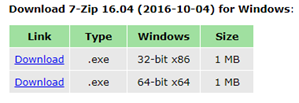
If unsure of the type that should be downloaded, select the link for the 32-bit version. Once the 7-zip utility is installed, return to TestHound.
To generate a registration file, click Performance Tracker, and select Registration Files. IF YOU HAVE PREVIOUSLY GENERATED A FILE, YOU WILL NEED TO DELETE IT TO REQUEST A NEW ONE.

Click Request Registration

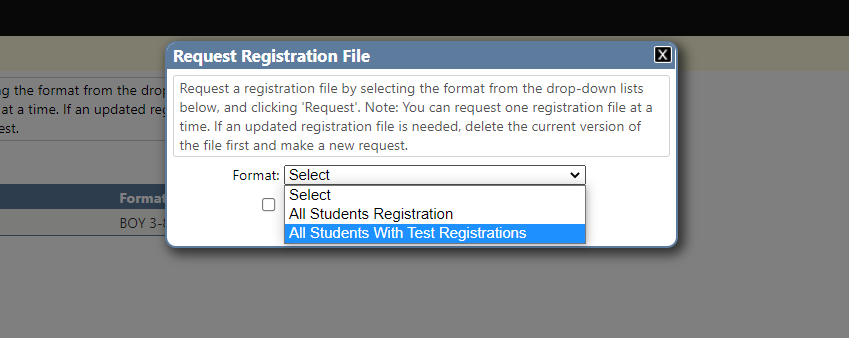
Select “All students with Test registration”. The file will begin to generate and you will receive an email when it is ready. You can return to the Registration page to download your file once it has been processed.
Once appropriate selections have been made, choose Request.

Files are processed in a queue and the length of time to generate the file depends on the size of the district and the number of requests ahead of the file in the system.

When the email is received with the notification of the registration file being ready, select Performance Tracker > Registration Files. A window will appear with the files that have been requested. Select the Download icon next to the appropriate file.

A new window will open requesting a 12-character password and select Download to receive the file. This password will be used to open the encrypted file.

When the file has been downloaded right-click or in Chrome select the arrow to the right of the file name, then choose Show in a folder. Open the Downloads folder on your computer to access the file.
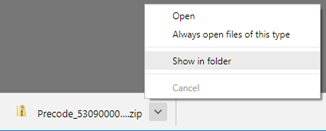
When in the Downloads folder a zipped folder titled Precode_ [District ID] _[Date] should appear.
Right-click on the zipped folder and choose 7-Zip > Show more options>Extract files Here.


A new window will open prompting the selection of a location where the files will be extracted and to enter the password that was created when generating the file in TestHound. Next, select OK.
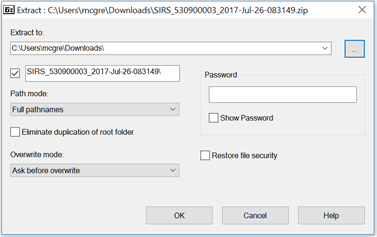
The window below will open indicating when the files have been extracted. When the process is complete, select Close.
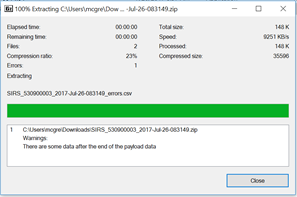
A new folder will appear within the designated location. Open the folder and within there will be two files.

The first file will be the registration file that can be submitted to the vendor to register students for testing. The second file Precode_[District ID]_Date_errors contains records indicating students who have incomplete data in the demographics file being submitted by the district and can be used to clean up the data being received through the demographic file.

Do student alerts need to be approved at the campus level for students to be included in the Registration file? Yes
If students do not have a past performance score in TestHound, First, add the students to the test administration at the campus level, then run the registration file at the district level. Any students in the test will be included in the file.
If in the Course Association, if two different course names have the same course code number, can they both be mapped? No, they cannot both be mapped, but they will both pull into the registration file as the course code number was mapped.
Do you have to map any courses for the December EOC? Only if you want to include a specific course code class for the test administration, otherwise it will include Retesters only based on scores loaded for students and any students assigned to the test.
How do you identify 3-8 above-grade testers? The STAAR Above Grade Level Report can be run after kids have been added to the test administration at the campus level.
Will students with a Score-O or Score-A be included in the Registration file? Yes, they will be included.
Once the registration file is generated it can be opened and manually edited as needed.
PLEASE NOTE when the registration file is opened to make changes, any leading zeros will be dropped if they are present within columns in Excel. Those leading zeros will need to be added back if any are removed in order for the file to successfully process.
Please follow the steps below as needed to return any leading zeros:
Highlight the entire column that contains data where leading zeros would need to be added
Right-click in the highlighted area and choose Format Cells
In the Category, select Custom

In the Type section, the word General will be in a text box, and also highlighted underneath
Click inside the text box (NOT the field with the items listed), delete out the word General and type in as many zeros as the field should contain. These act as a placeholder for the number of characters needed in the field.
For a (TX) District ID, you would put in six zeroes (000000)
For a TX Campus ID, it would be 3 zeros (000)
Check the date of birth and local ID columns as well
Once the updates are completed, save your document as .csv and then proceed with uploading the file for student registration.
I. Accessing the EOC Tracker- District Management

Step 1. From District Management, click on the Students Tab
Step 2. The link to the EOC Tracker is in the upper right-hand corner of the Student Tab Table
II. Filtering Students


Filtering Directions
Filtering a group of students can be done with a variety of options.
The district has the option to Filter and Export All Students, or All Students served by a program, Select a Campus, choose from Grades, Programs, and get a more specific list of students.
Step 1: Select a Campus
Step 2: Select a grade level or leave at Select to Show All Students
Step 3: Select from the different programs (SPED, LEP, 504, GT) to filter out students in the special programs
Step 4: If wanting to view the students that have failed or are missing an EOC, check this box.
Step 5: The filter can be used at any time after any of the selections are made. All boxes do not have to be populated to be able to filter. (Ex. If you only want to view students served by Sped, just use the Program filter and select Filter)
Step 6: Any filtered view can also be exported to Excel
III. Title Bar Filtering
Multiple filters can be done.
Click on the Title (Sped) and a list will be generated that brings all of the Sped Students to the top, if you select Sped again, it will re-sort them to the bottom of the list.
The LEP option can then be selected to bring to the top, students that are Sped and LEP.
The tests can also be sorted to show blanks at the top, to indicate a missing score/test.

Utilizing TestHound with TIDE system/Reports
STAAR 3-8 and STAAR EOC Assessments
*Verify the Accommodation Associations have been configured. To properly identify paper-based and computer-based test-takers and accommodations, the Accommodation Association must be configured to properly generate the Registration file and Test Attribute/Accommodation Report.
All Student Registration File
Click Here for a Video on How to Pull a Students Registration File

If you are not using Performance Tracker to pull the registration file, you can add the EOC flags to students using the Eligibility reports offered under district reports. Students must be in a test for the report to generate.

Step 5: Test Attributes/Accommodations Report
Students must be in a test in the system for this report to generate.
District+Test+Attributes+Overview.mp4Under District Management, go to Reports, select Test Attributes, click Request Test Attributes, choose Administration, and format=Test Attributes, then hit Request.




This report is for state assessments
From the district level, if a new attributes report needs to be run for a test administration, delete the original file and select Request Test Attributes to re-run the file.
This report, at the district level, will only contain ON values for students who need an attribute turned on. If the district uploads the file, and the student information changes, campuses will need to manually update it in TIDE or run the report at the campus level. The campus-level report contains ON and OFF values for all kids in the test.
Step 6: TIDE Roster Report (optional)
Under District Management, go to Reports, select TIDE Roster Report, choose applicable campuses, test administration, and Test(s), then Generate Report. Export the report in Excel format then upload it into TIDE. This report will help campuses to print tickets by room in TIDE.
Step 7: Other Designated Supports
Under District Management or Campus Management, go to Reports, select Other Designated Supports Report, choose applicable campuses, test administration, and Test(s), then Generate Report. Export the report in Excel format then upload it into TIDE.
Interim Opp and BOY Assessments
Step 1: Test Mode
The campus can make campus-wide Test Mode decisions as well as individual student Test Mode decisions. These selections will impact the Test Registration file. The decision of paper vs. online will appear in the registration file that is uploaded to the testing vendor.
Step 2: Adding Students to a Test Administration
Using the default Multi-Session Schedule interface, configure the test administration schedule, and add students to each applicable test.
Step 3: Student Registration File
Under District Management, go to Performance Tracker, click on Registration File link, click on the Request Registration link, select Test Admin and Format type BOY/Interim, then click the Request button. Download the Registration file, unzip using 7-Zip, the upload it to TIDE.
Step 4: End of Course Eligibility Report
Under District Management, go to Reports, select End of Course Eligibility Report, choose applicable campuses and EOC test administration, then Generate Report. Export the report in Excel format then upload it into TIDE.
Step 5: BOY EOC Eligibility Report
Under District Management, go to Reports, select BOY EOC Eligibility Report, choose applicable campuses, test administration, and Test(s), then Generate Report. Export the report in Excel format then upload it into TIDE.
Step 6: Interim Off-Grade Level Report, STAAR Above Grade Report
Under District Management, go to Reports, select Interim Off Grade Level/STAAR Above Grade Report, choose applicable campuses, test administration, and Test(s), then Generate Report. Export the report in Excel format then upload it into TIDE.
Step 7: Test Attributes/Accommodations Report
Under District Management, go to Reports, select Test Attributes/Accommodations Report, choose applicable campuses, test administration, and Test(s), then Generate Report. Export the report in Excel format then upload it into TIDE.
Step 8: TIDE Roster Report (optional)
Under District Management, go to Reports, select TIDE Roster Report, choose applicable campuses, test administration, and Test(s), then Generate Report. Export the report in Excel format then upload it into TIDE.
Step 9: Other Designated Supports
Under District Management or Campus Management, go to Reports, select Other Designated Supports Report, choose applicable campuses, test administration, and Test(s), then Generate Report. Export the report in Excel format then upload it into TIDE.
I. Accessing the Upload Exclusion feature
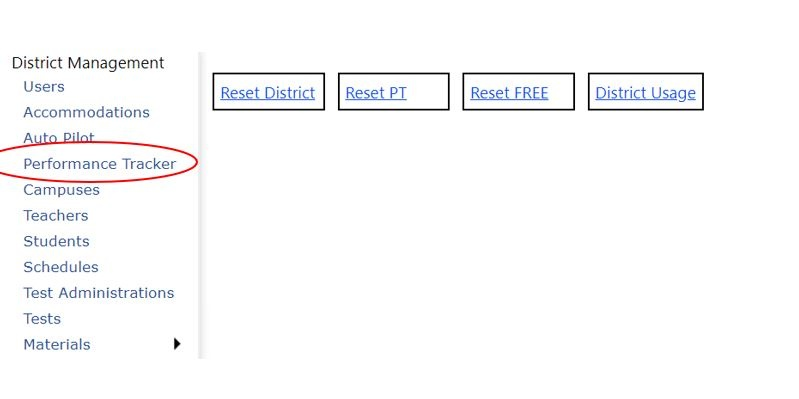
Step 1. From the District Management Screen, Click on Performance Tracker.
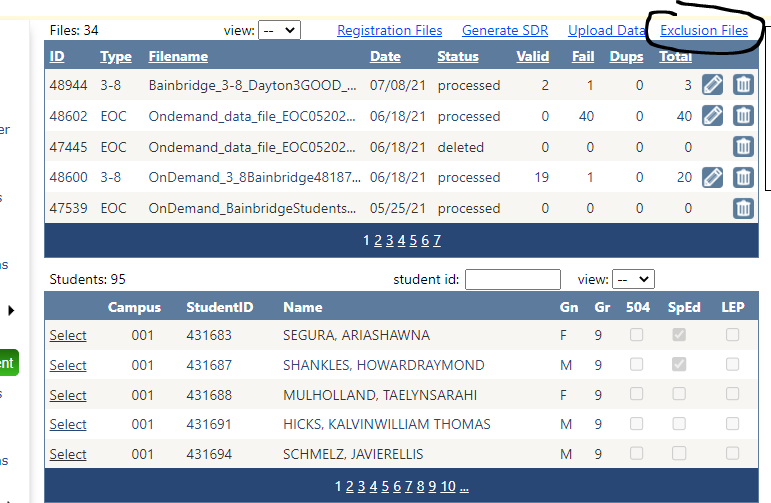
Step 2. Click on Exclusion Files in the upper right corner.
II. When creating a template to upload-it is helpful to name your files uniquely so they are easily identifiable later. You can download our template here or skip to step 4 to build your own.
Step 3. Download the template and populate it with the necessary fields

Step 4. Or in an Excel Spreadsheet, create the column headers- (this is beneficial if a spreadsheet has already been created for some fields).
DistrictID
StudentID
Grade
Course
Exclusion
Date
Note
III. Column Header-no spaces in the header titles

IV. Field Descriptions
Column Definitions | ||
DistrictID | Required; State defined six-digit DistrictID, no dashes or spaces | |
StudentID | Required; District's local StudentID; 1-10 digits in length, no dashes or spaces-please NO PEIMS IDs | |
Grade | Optional; integer values 3-12; [Note: required for STAAR exclusions] | |
Course | Required; allowed values: A1, BI, E1, E2, US | |
Exclusion | Required; allowed values: ALT2, ARD, CBE, E1 LEP, FEX, IGC, OS/PS, SA,WVR20-each exclusion will need it's own line of student data. Students will be listed multiple times for multiple exclusions | |
Date | Optional; allowed format mm/dd/yyyy; represents the date of the exclusion | |
Note | Optional; description or notes concerning the exclusion; 500 characters maximum | |
Courses | |
A1 | Algebra I |
BI | Biology |
E1 | English I |
E2 | English II |
US | U.S. History |
Exclusions | ||
ALT2 | STAAR Alternate 2 | |
ARD | EOC ARD Exempt – Special Education | |
CBE | Credit-by-Exam (CBE) | |
E1 LEP | English I Special Provision – LEP (Limited English Proficient) | |
FEX | Foreign Exchange | |
IGC | IGC – Individual Graduation Committee | |
OS/PS | Out of State or Private School | |
SA | Substitute Assessment | |
WVR20 | Waived-CVD 19 | |
V. Upload the Data
Step 1. Save the spreadsheet as a CSV (Comma-delimited-.csv) Note to Mac users: When saving the file, instead of choosing Save As CSV (Comma delimited), there should be an option for CSV UTF-8 (Comma delimited). Saving it with that format will prevent upload errors associated with the file format.
Step 2. Click on the Upload Exclusions link.
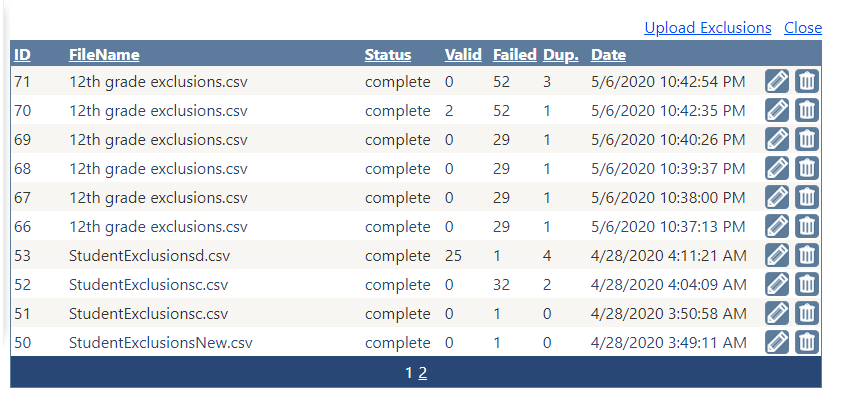
Step 3. Upload the .CSV file
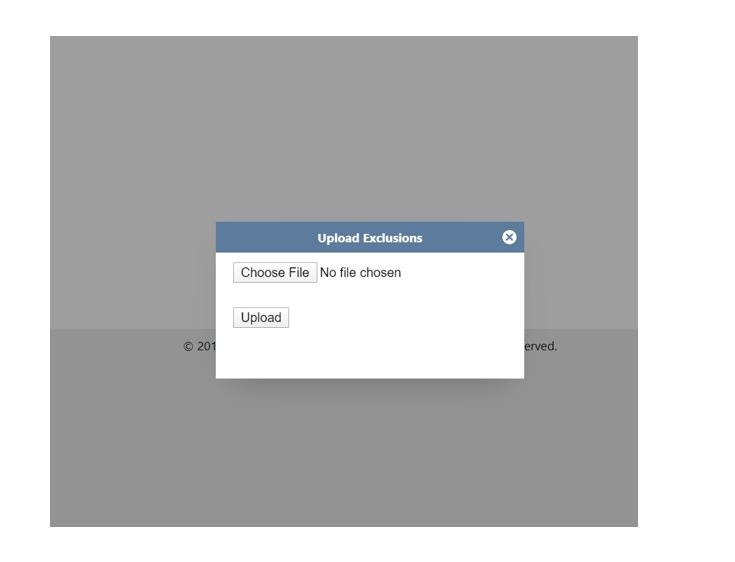
Step 4. When clicking on a student’s name, go to the Student Details Page (under Campus Management), the contents of the file will be applied to each student contained in the file.
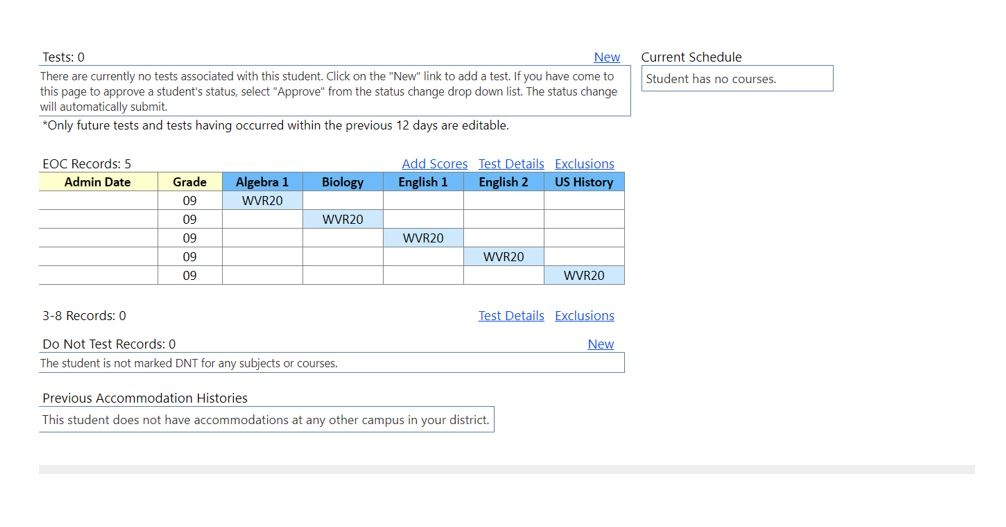
Step 5. After uploading the file, check for errors and duplicates by clicking on the Upload Exclusions button. Then the pencil beside the uploaded file. A list of duplicate records and invalid student IDs will be listed below.

Errors

Files can also be deleted to remove data from all students in the file, in case of errors, and then corrected and reloaded.
Mass+Exclusions+Upload (1).mp4
- No labels